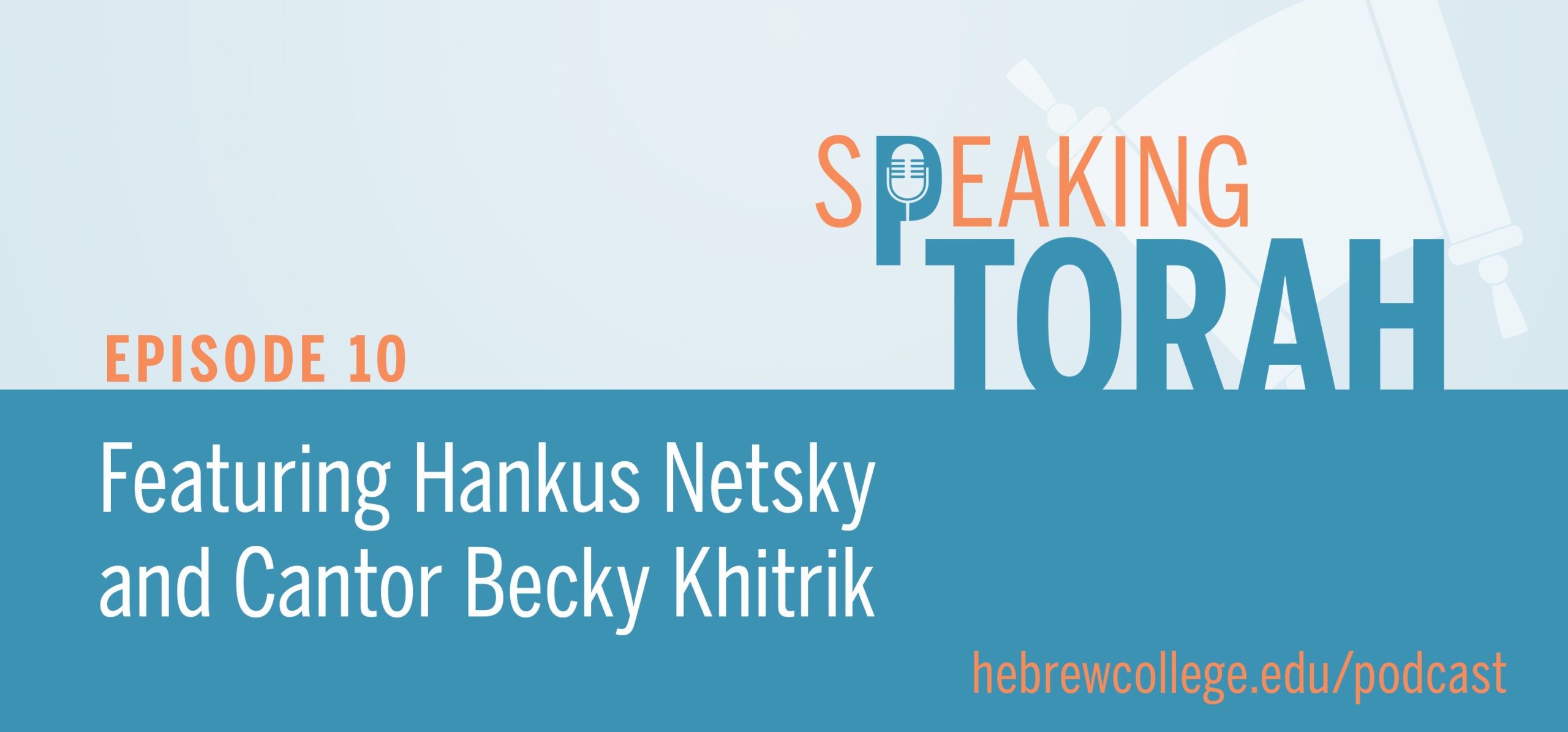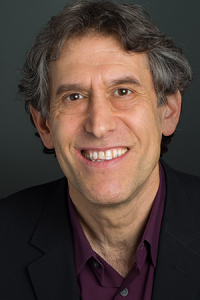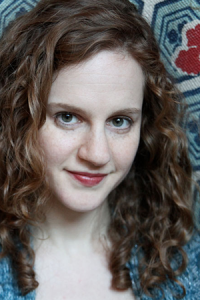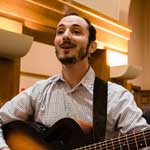Podcast Ep #10: Sounds of Klezmer

When you have a turn in the music, it’s a dreidel. It’s not just a turn. We describe emotions. We ascribe emotions to the way the music is played. In Western music, these are what we call ornaments. Like, you have the melody. You have the melody, and then you add a trill here and you add an é·chap·pé you know, some sort of thing, or a turn. These are not ornaments in Jewish music; these are ways of life.
– Hanuks Netzky
In this episode, instead of reading an essay, we’ve decided to play some Eastern European and Klezmer music. Then we’ll be talking to Klezmer Conservatory Band founder Hankus Netsky, along with Klezmer clarinetist and Hebrew College alumna Cantor Becky Khitrik, about their pieces and the evolution and influence of this type of music, from its U.S. revival in the 1960s until today.
A multi-instrumentalist, composer, and ethnomusicologist, Dr. Hankus Netsky is co-chair of New England Conservatory’s Contemporary Improvisation Department and founder and director of the Klezmer Conservatory Band, an internationally renowned Yiddish music ensemble.
Clarinetist Cantor Becky Khitrik is the Cantor at Temple Sinai of Sharon, Massachusetts, and an adjunct faculty member at Hebrew College. She received her ordination from Hebrew College in 2014. She holds a Bachelor of Arts Degree in Music and Religious Studies from Macalester College and a Master’s Degree of the Arts in Religion from Yale Institute of Sacred Music. She also plays with the band Klezwoods and formerly with The Lithuanian Empire.
Tune in to discover two unique takes on contemporary Eastern European and Klezmer music. Hankus Netsky is sharing his inspiration and wealth of experience on the revival of Klezmer music, and how it has been evolving over the past 45 years. And Cantor Rebecca Khitrik is discussing her influences and the musical melting pot that has brought Eastern European Yiddish music to where it is today.
What You’ll Discover from this Episode:
- Hankus’s early exposure to Klezmer music as a child and why he wanted to contribute to the resurgence of Klezmer Music.
- The inspiration Hankus drew from the Celtic music revival he witnessed in the late ‘70s.
- Why Hankus sees the resurgence of Klezmer music as having benefits and appeal far beyond the Jewish community.
- The innovation and characteristics of Klezmer music and how it’s still evolving even now.
- What compelled Cantor Becky Khitrik to share her love of the piece “Got Fun Avrom” and her band’s contemporary take on it.
- The changes and innovations in Eastern European music we can observe in “Got Fun Avrom.”
Featured on this Episode:



A special thank you for this episode’s musical contributions:

Jackson is an Ordination Candidate at the Rabbinical School of Hebrew College in Newton, MA. He grew up at Congregation Rodef Sholom in San Rafael, CA where he cultivated a love of Judaism, embolden with music, spirituality and justice.
Esa Einai (Psalm 121:1)
Music by Jackson Mercer
Guitar and Melody by Jackson Mercer
Harmonies by Cantor Rosalie Will, Ilana Sandberg, Rabbi Micah Shapiro, Rabbi Josh Warshawsky, Noah Diamondstein, Ryan Leszner, Eliana Light.
Got Fun Avrom
Arranged by Cantor Becky Khitrik
Performed by The Lithuanian Empire
“Firn Di Mekhutonim Aheym”
Performed by Itzhak Perlman and the Klezmer Conservatory Band.
Welcome to Speaking Torah. I’m your host Rabbi Jeffrey Summit, Director of the Innovation Lab at Hebrew College. In this podcast, leaders from Jewish communities around the country read essays by Hebrew College Rabbis and leaders. These essays tackle the pressing issues of our world that’s so in need to healing and hope, and they do so with Hebrew College’s signature compassion, creativity, and relevancy.
In this episode, we’ve decided to play some Eastern European and Klezmer music, instead of reading an essay. Then we’ll be talking to Klezmer Conservatory Band founder Hankus Netsky and Klezmer clarinetist and Hebrew College alumna Cantor Becky Khitrik about their pieces and the evolution of this music, from its US revival in the 1960s until today.
I’m excited to tell you a bit more about our guest. My friendships with the incredible Hankus Netsky goes back many years to when he was my teacher in a course at the New England Conservatory on Yiddish music performance styles. A multi-instrumentalist, composer, and ethnomusicologist, Dr. Hankus Netsky is co-chair of New England Conservatory’s Contemporary Improvisation Department and founder and director of the Klezmer Conservatory Band, an internationally renowned Yiddish music ensemble.
He’s composed extensively for film, theatre, and television and collaborated on major creative projects with Itzhak Perlman, Robin Williams, Joel Grey, Theodore Bikel, and Robert Brustein.
Clarinetist Cantor Becky Khitrik is the cantor at Temple Sinai of Sharon, Massachusetts and an adjunct faculty member at Hebrew College. She received her ordination from Hebrew College in 2014. She holds a Bachelor of Arts Degree in Music and Religious Studies from Macalester College and a certificate of study from the Zoltan Kodály Institute in Hungary.
She also holds a Master’s Degree of the Arts in Religion from the Yale Institute of Sacred Music.
She also plays with several bands. Her latest project is her album Rooted Lullaby, a collection of original lullabies in Yiddish, Hebrew, and English, created in collaboration with Heather Klein and Josh Horowitz and a choir from Temple Sinai, Las Vegas.
Now, here’s a musical clip from Hankus Netsy’s arrangement of Reels from County Klez. [Plays excerpt from “Reels from County Klez.”] Tell us about this piece. It feels a little different from traditional Klezmer.
Hankus Netsky: I chose to play what we call Reels from County Klez because it’s really a tribute to the people in the Celtic music world who, for me, were really the inspiration to reviving the Klezmer music of my family.
I heard music growing up from my grandfather, probably when I was three or four, I heard my uncles play at Jewish resorts. I knew there was this music. But it was really lost to me. Actually, it was not something that my generation was doing. It was not something that mainstream Jewish institutions encouraged in any way, shape, or form. They did have Cantorial music, but if you were an instrumentalist, there was nothing.
Meanwhile, I had recorded hours and hours of 78s of these incredible recordings that I just thought, “This is a gift for the world,” that there was this fantastic musical heritage that just needed to be shared one way or another. It was a time when there were a lot of resurgence going on in a lot of ethnic cultures.
And the Celtic music culture had really been revived, especially by two people; Séamus Connolly here in Boston and Mick Moloney in Philadelphia. And one time during vacation, some friends of mine just said, “Hey, let’s go to a Celtic music party.” And honestly, the first thought in my mind was, “Why would I want to do that?”
But I did join them. They were, by the way, both Jewish and fantastic musicians. One of them was a Brazilian musician who became Antonio Carlos Jobim’s music director. The other one was a friend of mine, Harold Smoliar, who became the English horn player for the Pittsburgh Symphony.
Anyhow, there we were, all the three of us going to a Celtic music session in 1978 at Mick Moloney’s house in Philadelphia. And we walked in and it was like another world. They had just transformed everything. I mean, there we were in Germantown in Philadelphia and we walked in and we might as well have been in County Cork – and it was completely different – Limerick, you know, somewhere like this. It was a completely different atmosphere.
In every room, people were playing hornpipes, people were singing sea shanties in another room. There were fiddlers in another room. And it was amazing to me. And I just kind of was a tourist. I went from room to room, listened to what was going on, went back to Boston and immediately put a notice in the Jewish student newspaper, which was called Genesis 2 – a wonderful paper that was around here for quite a bit that all the college students read.
And I just put a notice in there and said, “We’re going to have a Klezmer music session.” And nobody knew what Klezmer music was. So, I said, you know, “Klezmer jam.” And that was even good that nobody knew what it was. So people showed up. About 30 people, I would say, showed up. And I had food and I had some drinks. And I taught them the music that I had learned.
And immediately, Boston became a center for the resurgence of Klezmer music. It was really kind of that easy. But the fact that the Celtic musicians had really been responsible for that was not lost on me.
And as we’ve gone through the years, you know, Brian O’Donovan, who does the show Celtic Sojourn and Tommy McCarthy at the Burren in Sommerville and Frankie Gavin, the great Celtic fiddler, these have been some of our biggest supporters. And Frankie toured with Andy Statman in the 80s and played Klezmer music and Andy played his music. And we collaborated with Quebecois musicians – another offshoot of the Celtic tradition from La Bottine Souriante.
So, I mean, these resurgences of ethic culture – for, again, for the world, not just for some particular community – have really been a huge part of music, of the music scene, I’d say, in the last 50 years. And on the Jewish side, I just think it’s important to acknowledge how, at least for me, it was really the Celtic music revival that inspired the work that I do.
And I also would mention then that, you know, these are tunes actually from Galicia. These are Jewish tunes in that medley. In fact, I think – one of them, we know, dates back to the mid-1800s at least. They probably both do. And they’re both from what we call Russian dance tunes.
In this particular recording, also, we’re playing them in the style of Celtic music. My feeling is that, you know, I’m a musician. If I look back to try to find roots in music, I’m going to look at the most interesting music that I can find. And in the case of Eastern European Jewish Traditions, it’s really the only place where the Jews established a completely unique tradition.
In other words, you can’t take it and go, “Oh, that’s just the Jewish version of Polish music,” or, “That’s just the Jewish version of Ukrainian music,” or Bessarabian music or Belarussian music. No, it is a Jewish thing that is as unique – I mean, the comparison would really be, I would say, the most obvious one is African American music, where you have people who are living in a place where, of course, they’re getting musical prompts from what’s going on around them, but their condition is very different, the way they’re treated is very different. And so, their culture is very different.
And so, they invented huge amounts of really unique music. The Jews did this in Eastern Europe. Not so much in other communities. In most communities, the Jewish music is a Jewish version of what everyone else was doing. But really, in this particular community, they did. And sharing that tradition is very important.
But the other thing is innovating with it. So, when you have a type of music that has so many signifiers that are unique, so many elements that are unique, you can do a lot with it. You can really make it yours. And you can really take it somewhere where it’s never been before.
And that’s really what a lot of people in the resurgence of Klezmer music and Yiddish music have been doing in many cases; keeping the basic elements of it, but taking it in their own unique, individual direction. And that’s really the crux of what’s been going on now for close to 50 years.
Rabbi Jeffrey Summit: Let’s listen to the whole melody now, and then I have a few more questions for you. [Plays “Reels from County Klez.”] Tell me more about the characteristics and innovations of Klezmer music.
Hankus Netsky: I think of my neighbor, who was a Celtic fiddler, and I, at one point, asked him if he ever wanted to go to a Klezmer jam session. And he said, “Why would I want to play that? It’s so whiney.” And you know, I mean, obviously the whininess is what a lot of people respond to.
They notice that the music has whining sound, you know, it sounds like moan. The music itself is groaning and sobbing. And in fact, we refer to it that way. We say it has “krechtz,” which means groans and sobs. And who doesn’t have groans and sobs?
When you have a turn in the music, it’s a dreidel. It’s not just a turn. We describe emotions. We ascribe emotions to the way the music is played. In Western music, these are what we call ornaments. Like, you have the melody. You have the melody, and then you add a trill here and you add an é·chap·pé you know, some sort of thing, or a turn. These are not ornaments in Jewish music; these are ways of life.
Signifiers are what makes a culture unique. That’s what a signifier is. So, the fact that we have a lot of slides and we have [he makes sliding, whining sound] you know, if you’re playing, or “ya-ba, ya-ba“– if you play it without that, forget about it. It’s okay, you can do that, but it’s not Jewish anymore.
People look at Klezmer Conservatory and say, “Oh, traditional band.” No way, actually. If you really want to look at what we were doing, just by Don playing the clarinet and Frank London on the trumpet and Dave Harris on the trombone, they were bringing things into this that had never been brought in before actually.
And that’s what gave us an audience and actually helped to fuel the resurgence of the music, for Frank London to go then and work with The Klezmatics and Alicia Svigals and Lorin Sklamberg and these incredibly innovative musicians in New York City when he moved down there, or for Don Byron to put together his own Klezmer things or John Zorn, you know, one of the greatest musicians in the world, to do all his kinds of innovations around Jewish music that he did.
And of course, in our own time, right here in Boston we have Ezekiel’s Wheels doing their version of this. You know, Becky’s group also doing their version and adding to it. But we also have people in Montreal, we have Josh Dolgin, Socalled, who was a hip-hop DJ, who is a hip-hop DJ and who was able to take this in so many directions, you know, working that hip-hop and sampling thing into how you do this; sampling not just funk beats but Klezmer drummers or Yiddish choirs, I mean, bringing that into the mix.
There are so many things that you can draw on in this music. And it’s a worldwide phenomenon now and it’s something that people are bringing new innovations to all the time.
Rabbi Jeffrey Summit: Now we’ll hear a different take on Eastern European music. Listen to this clip of Got Fun Avrom, arranged by 2012 Hebrew College alum Cantor Howard Shapiro, performed by Becky’s band, The Lithuanian Empire, featuring Becky on clarinet. [Plays excerpt from “Got Fun Avrom.”] Tell me about this piece.
Cantor Becky Khitrik: “Got Fun Avrom,” or “Got Fun Avrohom” is a Hasidic text. It is a women’s prayer that is traditionally sung or read as the Sabbath is departing, right before Habdalah. The text is attributed to the Hassidic Rebbe Levi Yitzchock of Berditchev, who according to tradition also wrote several other Yiddish songs. And there is a simple text variant that’s found in the Artscroll Siddur, which I was drawn to immediately because it’s a little island of Yiddish amidst a large volume of Hebrew.
There are a lot of musical settings of this text and the niggun that I used is also a Hassidic niggun which I learned at KlezKanada from a teacher of mine, Sruli Dresdner, now Rabbi Sruli Dresdner. And the melody is used not for this text in its original context. It’s used for the High Holidays.
But I was really drawn to this particular melody and I think that the arrangement that we used in the recording, which is with the band The Lithuanian Empire, speaks to the possibilities of what could happen in a beautiful week to come.
So, this text asks God for all of the good things we want; mazel, we want luck, we want parnasa, we want good luck with our finances. So, we want strength, we want health, we want kindness, we want to be close to God. And there’s beauty in the possibility of a new week that we explored as we were improvising.
There’s a long section of free improvisation that opens the arrangement. And we had so much fun playing with each other, having a musical conversation before we got into the meat of the melody, which gets me every time. It’s so beautiful.
There is a secret quotation in the trombone line from a pop tune from the 80s. I won’t give it away. But if you have really keen ears, you might be able to hear the quote. It’s a musical joke.
Rabbi Jeffrey Summit: Now let’s hear the entire piece. [Plays “Got Fun Avrom.”] Would you talk a bit about the changes and innovations in Eastern European music and what we could hear in this piece?
Cantor Becky Khitrik: KlezKanada, which is a festival for Yiddish culture and the arts – I started attending the festival in 2004 and went for 15 years straight. KlezKanada is a unique situation because it is a melting pot that draws a lot of international artists, not just from Canada and the US, but from Central and Eastern Europe.
And I think that this really special magic that happens there is that there are musicians and artists with lots of different performance esthetics and so going to KlezKanada exposed me to so much – a musical melting pot, I’ll say – that I might not have encountered had I been in specific communities that were a little bit more bubbled or cloistered.
And I was thinking about it because we often talk about this generational difference with old-guard players, particularly of Klezmer revival founders who were imitating old recordings really closely and trying to produce – to the best of what they could, they were trying to produce replicas of those old recordings.
And we talk about generational shifts where younger players then come in and bring in different sounds. So, influences from jazz or pop or techno music. But I don’t actually think – as I get older, I don’t actually think it is a generational divide. I think that it’s just exploration of different voices and different sounds and there’s a multilayered music-making approach that’s happening now.
And I think that in 2021, I think we can safely say that we’re post-Klezma revival and we are all having fun exploring together what it means to make Jewish music.
Rabbi Jeffrey Summit: Thank you for joining us for this episode of Speaking Torah. We want to thank Emily Hoadley for our logo, and Hebrew College Rabbinical student and composer Jackson Mercer for our theme music Esa Einai. To learn more about Hebrew College, please visit hebrewcollege.edu/podcast. And remember to subscribe, like, and rate Speaking Torah on Apple Podcasts, Spotify, or wherever you listen to podcasts.
We’ll leave you this week with Hankus Netsky’s version of “Firn Di Mekhutonim Aheym” performed by Itzhak Perlman and the Klezmer Conservatory Band. Visit the website for a link to the full piece, as well as Becky’s version of the same piece. I’m your host Rabbi Jeffrey Summit. See you next time on Speaking Torah.
Enjoy the Show?
- Don’t miss an episode, follow the podcast on Spotify, Apple Podcasts, Stitcher, or RSS.
- Leave us a review in Apple Podcasts.


